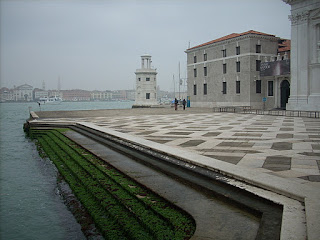We are about to leave Venice without ever really experiencing acqua alta. Nevertheless, it is such a fascinating phenomena that I will go ahead and write a bit about it anyway. The first thing to know is that acqua alta (high water) refers to the seasonal flooding that affects Venice. It occurs usually twice a year, between February and April and then again between October and December, and is caused by a combination of factors.
Factor 1 - high high tides occurring seasonally in spring and autumn.
Factor 2 - rain in the mountains, flowing down the rivers into the lagoon.
Factor 3 - rain in the lagoon.
Factor 4 - wind blowing off the Adriatic and into the lagoon.
The first three factors cause the lagoon to become very full of water. The fourth factor - the wind - stops the outgoing tide from leaving the lagoon, and then the next incoming tide is added to the already swollen lagoon, causing flooding. As far as I can tell, this season we only got factor 1 - dramatically high and low tides. While C&C were here we also had a little rain, causing some minor flooding. But it only lasted one day, well one high tide, and we haven't needed gumboots since. (Except maybe for one day when it rained and rained, but then there was no high tide to make it flood.)
As Venice is up and down and all over the place, different parts of it are affected to differing extents by flooding (for example the canal edge opposite us flooding while we remained well above the high water level). When we first visited our apartment, as it is on the ground floor we had been reminded by Svetislava to ask about acqua alta. We had visions of spending October on a floating bed, donning gummies to get to the kitchen or the bathroom. But our landlords laughed at the terror in our eyes and explained that they had undertaken mitigating factors when they renovated and that we'd be safe and dry. Well, for whatever reasons, they were right. (At the time we also looked at a topographical map of Venice that showed its varying heights and basically the whole place is tilted - the northern edge (where we live) at the top, San Marco and the south at the bottom.)
 |
| A snazzy pair of bright orange galoshes in a shop front window display. |
 |
| Residual water after some flooding in Piazza San Marco - one of the lowest points in Venice. |
 |
| Another low point, near Rialto market. |
Another problem of course is that Venice has always been sinking. Gradually the large heavy buildings subside into the soft alluvial sediment that forms the lagoon floor. Buildings here are constructed on really long wooden piles, like under a wharf, which petrify rather than rot in low oxygen conditions - but how many wooden sticks do you need to hold up one of those huge brick buildings? Very very many, probably more than you bother putting in. For the first five hundred years or so the sinking was likely slow enough not to cause too great a concern, either that or buildings just collapsed. Then in the 1950s, Marghera, an industrial centre on the mainland edge of the lagoon, ramped up production and greatly increased water extraction from the aquifer running under Venice. This water extraction led to the land in the lagoon (equivalent in size to Wellington - 450 square kilometres) sinking about 130mm, that's about the width of your handspan. In the 1970s, when they realised what was happening, pumping stopped the the lagoon floor was stabilised. This was after the worst aqua alta flooding on record, in November 1966 when the whole of Venice became submerged. So anyway, the result of this experiment in sinking a city has lead to quite a lot of interesting architecture - very short ground floor doorways and columns, and ramps and steps leading down to the original floor level of old buildings.
The upshot of all this sinking is an increased vulnerability to flooding. With probable sea level rise due to climate change, the authorities in Venice have taken this issue very seriously. Their answer is the largest infrastructure project ever undertaken in Italy - MOSE. I think that it is both an acronym and the Italian for Moses. The project is seeing the installation of massive steel balloons that sit under the three entrances into the Venice lagoon from the Adriatic. When a tide of between 110cm and 300cm above mean is predicted they fill these balloons with air, causing them to rise up and form a barrier, holding back the tide from entering the lagoon and preventing the worst flooding. At an expected cost of around €4.2 billion it might be an affordable solution to rising sea levels for Italy, but it leaves me a little uneasy. If it costs that much to protect one lagoon from sea level rise, what are island groups such as the Mauritius or Tuvalu, or for that matter anywhere else in the world supposed to do?
A blogging collaboration between the two of us, both writing in the first person...
27 November 2011



























































